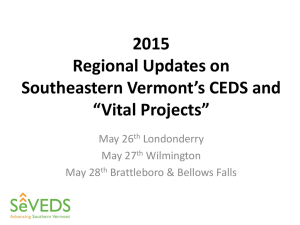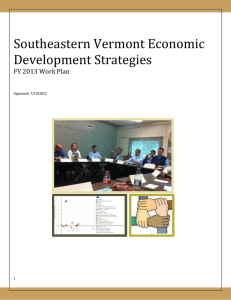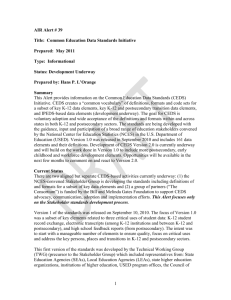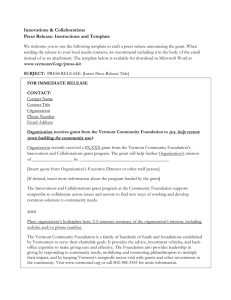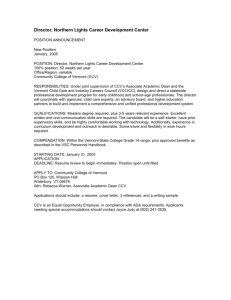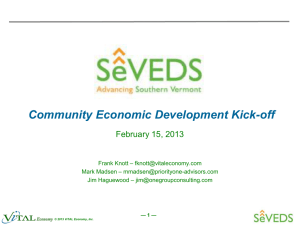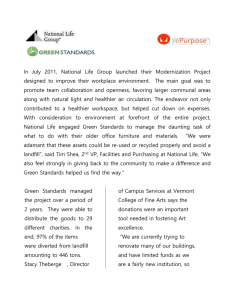CEDS Public Process 120513
advertisement
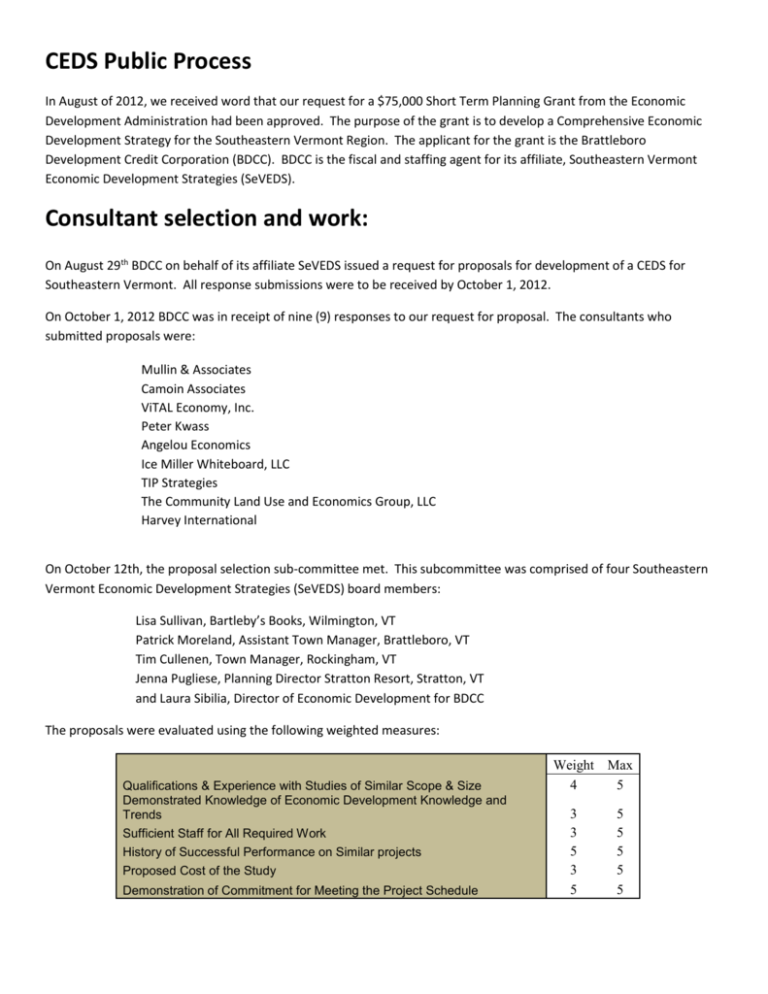
CEDS Public Process In August of 2012, we received word that our request for a $75,000 Short Term Planning Grant from the Economic Development Administration had been approved. The purpose of the grant is to develop a Comprehensive Economic Development Strategy for the Southeastern Vermont Region. The applicant for the grant is the Brattleboro Development Credit Corporation (BDCC). BDCC is the fiscal and staffing agent for its affiliate, Southeastern Vermont Economic Development Strategies (SeVEDS). Consultant selection and work: On August 29th BDCC on behalf of its affiliate SeVEDS issued a request for proposals for development of a CEDS for Southeastern Vermont. All response submissions were to be received by October 1, 2012. On October 1, 2012 BDCC was in receipt of nine (9) responses to our request for proposal. The consultants who submitted proposals were: Mullin & Associates Camoin Associates ViTAL Economy, Inc. Peter Kwass Angelou Economics Ice Miller Whiteboard, LLC TIP Strategies The Community Land Use and Economics Group, LLC Harvey International On October 12th, the proposal selection sub-committee met. This subcommittee was comprised of four Southeastern Vermont Economic Development Strategies (SeVEDS) board members: Lisa Sullivan, Bartleby’s Books, Wilmington, VT Patrick Moreland, Assistant Town Manager, Brattleboro, VT Tim Cullenen, Town Manager, Rockingham, VT Jenna Pugliese, Planning Director Stratton Resort, Stratton, VT and Laura Sibilia, Director of Economic Development for BDCC The proposals were evaluated using the following weighted measures: Qualifications & Experience with Studies of Similar Scope & Size Demonstrated Knowledge of Economic Development Knowledge and Trends Sufficient Staff for All Required Work History of Successful Performance on Similar projects Proposed Cost of the Study Demonstration of Commitment for Meeting the Project Schedule Weight Max 4 5 3 3 5 3 5 5 5 5 5 5 The top scoring three proposals were selected for reference checks and phone interviews with the subcommittee: Mullin & Associates, Camoin Associates and ViTAL Economy, Inc. References were checked by Laura Sibilia and phone interviews with the entire subcommittee were held with each of the consultant groups on October 16th. On October 18th, the subcommittee made a recommendation to the SeVEDS board for ViTAL Economy, Inc. to be contracted to develop the CEDS for Southeastern Vermont. Jeff Lewis, Executive Director for BDCC and a SeVEDS board member was asked to develop and sign a contract with ViTAL Economy, Inc. On November 30th a Letter of Agreement was signed between ViTAL Economy, Inc. and BDCC. The LOA indicates that a CEDS will be presented for 30 day public comment on September 19th, 2013. On January 18th the SeVEDS Board met with Frank Knott from ViTAL Economy in person and Mark Madsen via Webex for a 5 hour training session. The agenda for the training session: 1. Introductions and overview 2. Review objectives (why are we doing a CEDS) 3. Changing EDA requirements 4. Best Practice CEDS examples 5. CEDS Committee's roles and responsibilities 6. CEDS Process including: regional profile community meetings final document adoption of final document On February 14th the SeVEDS Board met with Frank Knott and Mark Madsen of ViTAL Economies in person and approved the following CEDS committee membership: SeVEDS Board PLUS Connie Snow – Windham Windsor Housing Andy Robinson – Department of Labor Rachel Selsky – Camoin Associates Stephanie Huestis – Peoples Bank Dutch Walsh – Town of Rockingham Gail Nunziato – Latchis Chris Moore – Lawyer Bill Anton – Dover School Principal Oliver Olsen – Oracle Roger Albee– former Secretary of Agriculture On February 14th the CEDS Committee met with Frank Knott and Mark Madsen of ViTAL Economies in person with the following agenda: Introductions Review official CEDS Committee membership confirmed by SeVEDS Board action (17 public, 7 non-profit, 5 public total of 59% private) Review CEDS subcommittees and purpose o Event Planning –schedule for regional meetings o Communications o CEDS development task force Review & Discuss updated Issues of Challenge and Opportunity and Presentation for February 15th public meeting *materials attached Public Engagement: On September 13th, SeVEDS held its first annual public meeting in Bellows Falls. A public presentation on the regional economy and plans for the coming years was delivered to approximately 100 attendees. A request was made to be invited to speak to all 27 towns in the region. Speakers included: Ted Brady, Senator Leahy’s office Secretary Lawrence Miller, Vermont Agency of Commerce & Community Development Shap Smith, Vermont Speaker of the House Jeff Lewis, Executive Director BDCC Barb Sondag, Brattleboro Town Manager Lisa Sullivan, Chair SeVEDS Board On October 15th, all 27 towns in the region were mailed a hardcopy request to appear on their select board agendas to update the boards on SeVEDS and the upcoming CEDS process. The mailing also included the SeVEDS FY 13 work plan. As of December 18th, Laura Sibilia and a total of eight SeVEDS board members have spoken at 15 different town select board meetings. On February 15th SeVEDS and the Windham Region CEDS Committee sponsored the CEDS public kick off meeting at the Brattleboro Retreat Education Conference Room from 8:30-11:30. The public was invited to attend the meeting through press releases published in the regional newspaper the Brattleboro Reformer, the weekly Deerfield Valley News, WTIC and WKVT FM radio stations located in Brattleboro, Vermont Public Radio and an emailed newsletter including invitation to all 27 towns selectboard and planning commission chairs, the Windham County state legislative delegation, the Windham regions top 50 largest employers, all Windham Region chambers of Commerce. Approximately 65 participants attended the meeting. That meeting was videotaped and posted to www.SeVEDS.com. The meeting was reported in The Commons, The Brattleboro Reformer and on Vermont Public Radio. At the kick off meeting, a small vocal segment of community activists suggested that improving the economy was not the right thing to do, rather the region should concentrate on learning to do more with less. The phrase “Windham County is ahead because it is behind” was spoken. Some employers and Young Professionals spoke to contradict that notion during the second half of the meeting. Two sets of four regional public input meetings in Brattleboro, Bellows Falls, Londonderry and Wilmington were publicized. The dates for these two sets of four regional public meetings were in March and May. The scheduling of these meetings in March and May was done to intentionally to miss common region vacation times in April and June. On Sunday March 17th a decision was made to reschedule the two sets of four regional public meetings in March and May due to an impending significant series of snow forecasts likely to impact both the travel of the ViTAL Economy team and the attendance at at least two of the region meetings. The two sets of four regional public meetings were rescheduled for April and June. During the week of April 22nd, Frank Knott from ViTAL Economy conducted 4 regional sessions, managed input from 8 focus groups, updated the Brattleboro Development Credit Corporation board and trustees on CEDS at their semiannual meeting and conducted a CEDS readiness assessment with the CEDS committee and met with over 270 regional representatives and members of the public. The meetings were as follows: Tuesday, April 23: o 8:30 to 11:30 am: Regional Meeting, Lower Theater, BF Town Office (27 participants) o Noon to 1:30: Round table discussions, Lower Theater, Lunch provided Group 1: Manufacturing (7 participants) Group 2: Tourism/Hospitality (4 participants) o 4pm: BDCC Semi Annual Meeting Brat Retreat (50 participants) Wednesday, April 24: o 8:30 am to 11:30 am: Wilmington Regional Meeting (41 participants) o 1:30: Round Table Discussions, Hannah C. and Brattleboro Selectboard rooms, refreshments Group 1: Working Lands: Agriculture and Forestry (12 participants) Group 2: Professional, Scientific, Technical, IT, Creative Economy (10 participants) o 6pm to 8:30 pm: Londonderry Regional Meeting (19 participants) Thursday, April 25: o 8:30am to 10am: Roundtable discussions: Group 1: Heath Care: Brattleboro Select board meeting room (10 participants) Group 2: Higher Education: Hanna Cosman meeting room (8 participants) o 10:30 to noon: Roundtable discussions Group 1: Workforce, Brattleboro Select board meeting room (10 participants) Group 2: Finance, Insurance, Real Estate: Hanna Cosman (15 participants) o 2pm to 4:30pm: SeVEDS Board and Exec. Committee: Readiness assessment o 6pm to 8:30 pm: Brattleboro Regional meeting, Select board meeting room (50 participants) Highlights from the April focus groups: A series of eight focus groups were held in April 2013 as part of the process to create a regional economic development strategy for SE Vermont. Below are the top leverageable assets that were identified by those groups (in green) and the top opportunities for strategy development (in blue). Following this list are summaries of each focus group with challenges and obstacles to growth also included. Manufacturing: Advantages to being located in Windham County include access to the interstate system and rent costs which are less than Chittenden County. Bus service was cited as an asset Proximity to the political and governmental organizations. You can reach officials on the phone. Business in VT is very personal. Most important factor in recruitment are school quality and proximity to quality healthcare. Additional incubators needed for startups. UMass has active medical device entrepreneurial program. Initiative that focuses on that would be good. Colleges: Need internship opportunities. All agree that colleges must collaborate to work with ski resorts to optimize opps. Need a seamless way to take credits from diff colleges and make a seamless, valid degree. Finance, Insurance, Real Estate (FIRE) We need more help for people assembling finance and assistance on real estate. We have a lot of job openings we need 35-40 year olds with experience, technology skills updated People with children looking to come here (schools). Tourism Vermont brand is strong, and the scale of Vermont is advantageous. We have good proximity to market of affluent clientele (drive market) who enjoy the cultural experience and the quality of life Snowmaking is superior, a game changer over Western - Why? – Because we have to have it. South American economy rise is a huge opportunity for Vermont ski areas - “We should own this” “There is a misalignment of objectives of economic development and regulation” Transportation coordination for out of state visitors would be helpful (i.e. busses w/Amtrak schedule) Workforce Need to survey what are the skill levels that need to be replaced? What is the expectation of the skills levels of that future workforce that is supplied? Working Lands A great wood shed here in NE. Exceptional resource in large diameter timber. VT brand is helpful, should be a state priority. Supply chain is less robust here (decrease in this). I have to go further out for farm parts. More foresters are needed to serve needs of private landowners who are committed and have questions for professionals. We need a list of and network of brokers and distribution yards for timber. Is there opp to create a sustainable market building niche here? Want/need: a knowledge hub and manufacturing hub here. Professional, IT, Scientific Snowboarding at Stratton proximity to New York and Boston People in this focus group experience “the arts” in a feeling that community is alive, creative people, music venues, Gallery Walk, little bit of underground art scene “tasteful graffiti – Woodstock, VT is old people art – enough of raw edge here in Brattleboro to attract young people. Members of this focus group felt if the state is successful with single payer – small business will flock here and they consider Vermont incubator for social ideas (basically) – healthcare, gay marriage, public education, and abolition of slavery – feel that story can help attract entrepreneurs. Quality of schools systems is a big deal Bandwidth need over a meg a second. first town in with new technology gets massive tourism influx. Need more Co working space and part time office space. Healthcare shortage of IT and admin. shift to nurse practitioners due to doctor shortage. Technology integration - health care. Population health management collaboration (BMH, SWVMC, GC) Advocacy of hospitals as economic driver After these meetings in April we received the following observations, feedback and items for further follow up from ViTAL Economy: 1. Survey two young constituencies... 17-21 and 22-44 age groups. These are the critical age groups for SevEDS future. 2. CEO of Brattleboro Retreat expressed interest in speaking with ViTAL Economy 3. Bring together a group around renewable energy and sustainable building products and services. This is a potential niche market opportunity with assets that appear to be in greater abundance in the region. 4. In terms of the poverty issue in the region, work with some of the school principals to help develop a pattern across the region of the speed of increase in school lunch program expenditures as a percent of students. Growth in drug related and mental health emergency room admissions. 5. Interest in local foods and sustainable agriculture related to tourism and other aspects of the region. 6. Housing is a key and multi-faceted issue. There are issues of rents not able to support construction costs of new housing, the impact of subsidized housing on specific communities, and issue of affordable workforce housing that gets in the way of attracting high skilled knowledge worker families. 7. Current CEO of World Learning says they are announcing a new CEO in about 10 days. They are a large $140 million/year international enterprise in the region. The current President indicated that the new President would be open to our interest in leveraging the international footprint of World learning to expand the multi-cultural nature of the SeVEDS region. 8. Finance is an ever present issue in all the discussions we had this week. Discuss getting a core group of public and private financial executives together to discuss option SeVEDS should consider. 9. The issue of capacity building at the town level and the need for a regional redevelopment capacity came up a number of times. Put a brainstorming team together in June to discuss options. Explore the potential for a public/private entity, which many communities use. This is essentially what BDCC is and may have the capacity to grow into such an entity for the whole region. Based on this feedback and the input from the community added to the regional profile data the following schedule and focus groups were set up with ViTAL Economy in June: o Tuesday, June 25th: 8:30 to 11:30 am: Regional Meeting, Lower Theater, BF Town Office Noon to 1:30: Round table discussions, Lower Theater, Lunch provided Group 1: Regional redevelopment capacity building 3:30 to 5:00 pm Roundtable discussions: Group 1: Arts and culture BDCC Conference Room Group 2: Education Hannah Cosman Brattleboro Town Office o Wednesday, June 26th: 8:30 am to 11:30 am: Wilmington Regional Meeting 1-2 Frank lunch with Rob Simpson at Retreat 7pm to 9:00 pm: Londonderry Regional Meeting o Thursday, June 27th: 10:30 to noon: Roundtable discussions Group 1: Focus Group: ALEX Wilson Select board meeting room Group 2: Focus Group: Housing Hanna Cosman meeting room. 2pm to 4:30pm: SeVEDS Board and CEDS Committee Meeting 7pm to 9:00 pm: Brattleboro Regional meeting, Retreat Education Conference Room o Friday June 28th: 9:00 to 10:30 Group 1: Low income/underserved population BDCC conference room Young Professionals Survey Young professionals were surveyed for a two week period of time beginning May 29 2013. They were surveyed using an online tool with approximately 80 respondents • Average respondent age: 36.5 years • 70% married • 50% of respondents work in Brattleboro • 24% of respondents work in Dover/Wilmington • Notable lack of responses from Londonderry, and Bellows Falls/Rockingham • 44% of respondents have bachelor’s degree, 39% masters • Cited as “Strength of Region” • 37% cited politics (a common word was progressive) • 25% cited outdoor recreation opportunities • 24% cited scenic beauty • 22% cited arts • schools, cultural diversity and locavore/working lands each were cited by 18% of respondents Note: Total greater than 100% as more than one response allowed on this question • 66% plan to be here in 5 years • 31% don’t know if they will be here in 5 years • 65% of respondents replied that loss of their job, or their spouse/partner’s job, as a primary reason they would leave the region Regional weaknesses cited: • “There is no high tech culture at all. It is a challenge to even communicate with community meetings or groups with Skype.” • “High cost of living (food, rent, gas), low wages, lack of robust job market, poor telecommunications infrastructure, lack of convenient public transportation locally and to nearby metropolitan areas (esp. Boston).” • "There is a real split among the young folks who are here. There is no cohesion among young professionals.” • “Lack of a large university.” • “Lack of ethnic/race diversity.” • “Limited nightlife opportunities.” • “Lack of county-wide government structure to drive regional policy.” • “Reliance upon tourism rather than self-sustaining economy.” • “The few networks that do exist (business, economic development, arts/culture, nonprofit, etc.) are not collaborating across sectors.” • “Jobs in the region do not pay comparable salaries to other regions and high taxes make homeownership challenging, even with two incomes.” • “We do not operate on a regional level - Vermonters and southeastern Vermonters in particular, are very vested in being "different and special" from other areas of the state and region.”
